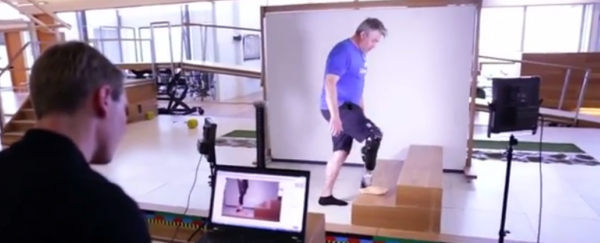Scientists in Iceland have invented new bionic prosthetic limbs that can be controlled by a person's thoughts alone, and they're so good, two patients are already trialling the technology.
Developed by a company called Ossur, the world-first technology involves surgically implanting 5 mm by 3 mm myoelectric sensors (IMES) into a person's residual muscle tissue to measure and interpret the signals travelling between its nerve-endings and the brain. Leg movement is triggered by a connected receiver, and the process is so streamlined, it allows a patient to perform actions subconsciously.
"The brain power, when it takes over, actually gives impulses through the brain into the muscles, then the muscles contract," orthopaedic surgeon and director of research and development at Ossur, Thorvaldur Ingvarsson, told Amy Pollack at Reuters. "We put sensors into the muscles, and the muscles would pick up the signals, and the signals move their way into the prosthetics, and then the prosthetics react as your brain wants."
The technology differs from similar mind-controlled prosthetics because it doesn't require muscle tissue to be transplanted from another part of the body into the affected area, says Pollock. This requires an intense amount of mental training by the patient, because their brain has to get used to their muscle tissue functioning in a completely different region of the body.
One of the two amputees who has been trialling the bionic legs for the past 12 months, Gummi Olafsson, described to Pollock the bizarre feeling of controlling a piece of technology like it was a natural part of his body:
"As soon as I put my foot on, it took me about 10 minutes to get control of it. I could stand up and just walk away. Come back, sit down, use my muscles to move my foot in the position I wanted to use it. It was like you couldn't believe the feeling when you were moving your ankle. It was really strange. I couldn't explain it. It was like, I was moving it with my muscles, there was nobody else doing it, the foot was not doing it, I was doing it, so it was really strange and overwhelming."
Olafsson added that practice is everything when it comes to figuring out how to better manipulate the bionic legs, and is now working on diversifying his skills to get him uphill, downhill, upstairs, downstairs, and sitting and standing on a chair.
And what's really awesome about this technology is that it's compatible with current bionic legs that amputees around the world have already gotten used to. Patients will now be able to upgrade their existing prosthetics, which have already been adapted to their individual walking style, with the capacity for mind-control.
Ingvarsson says that the next step for the technology might be to embed a network of sensors into the prosthetic limbs to create a feedback loop about what's going on in the surrounding environment, similar to how sensors in driverless cars create an impression of the pathways and obstacles around them.
Watch the technology being tested here.
